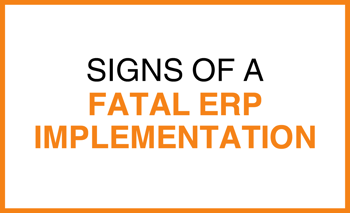4 Signs of a Fatal ERP Implementation
 There can be no worse feeling than taking a look at your ERP system a few years after an implementation and realizing that it’s just not working. One of our clients had that exact realization not long ago; only five years after they initially implemented their ERP system they contacted our team for a complete overhaul, as their system simply wasn’t meeting their business needs.
There can be no worse feeling than taking a look at your ERP system a few years after an implementation and realizing that it’s just not working. One of our clients had that exact realization not long ago; only five years after they initially implemented their ERP system they contacted our team for a complete overhaul, as their system simply wasn’t meeting their business needs.
While it may not have been initially obvious to our client, our team noticed some serious red flags with their ERP as soon as we were brought on board. There are a number of things that you can keep an eye out for after an ERP implementation that will indicate if the system is working or not. Here is our list of signs of a fatal ERP implementation.
Business Processes Aren’t Improving
If the new system isn’t easing or improving business processes, then you might have a fatal ERP implementation. For example:
- Month end close takes more than seven days, or takes significantly longer than it did before the implementation
- There are inconsistencies in reporting between modules
- You’re missing delivery commitments or contract targets
If, even after going through testing for all processes and pushing through to production, you find that the business processes aren’t efficient or are generating errors, then your new system is most likely constraining your business processes.
Goals Aren't Being Met
When implementing an ERP system, you first have to identify your “as is” scenario, then determine what your “to be” scenario will be. If, post-implementation, your ERP system doesn’t match your “to be” process flows, then there is a disconnect somewhere.
Additionally, when determining the steps of your implementation project, some priorities will inevitably get pushed to Phase Two, once the Phase One tasks of implementing your ERP are complete. But, if you find that you are constantly working to maintain or improve upon the foundation of Phase One, and therefore aren’t making it to Phase Two, your ERP system isn’t living up to your expectations.
In general, if you aren’t hitting your key success metrics or, even worse, they’re going in the wrong direction, then you need to take a serious look at your ERP. Whether your goals were to shrink your order to cash cycle, reduce overall inventory, increase inventory turns, or get your DSO down, pay close attention to those metrics. Their growth or decline will be the first indication that something isn’t right with your implementation.
Staff Activity
The first people to notice if something is amiss will be the business folks using your ERP system. If they don’t trust the information coming out of the system, avoid using it, or even openly mock the new system, then make sure to talk to them about why there is so much distrust. Addressing those problems early could make a difference.
Another indicator is if your IT department is continually working on the basics or maintenance of your ERP system instead of making progress on new products or services. They shouldn’t be worried about basic blocking and tackling just after an implementation.
One problem we never like to see is when the new ERP is making the customer service team’s job harder, rather than easier. If calls to your CSR desk are increasing, or even just not decreasing, you’re getting more complaints, or it’s taking longer to place orders, that’s an indicator that something is wrong.
Your Implementation Partner is MIA
The kiss of death for your ERP implementation? If your implementation partner has disappeared. If any of the above issues are occurring, you should be able to reach out to your implementation partner to work out a solution. But if they are dodging your calls and not responding to emails, you’re in trouble. They might know they did shoddy work and not want to deal with the backlash, or they could just be a subpar partner.
Make sure you do your research and partner with an experienced, reputable team that will be with you all the way through your implementation, including any necessary follow-up fixes once you go live.
Do any of these issues seem familiar to you? Contact our team to find a solution, or click below to learn how a Business Process Improvement Review could help solve these challenges.

